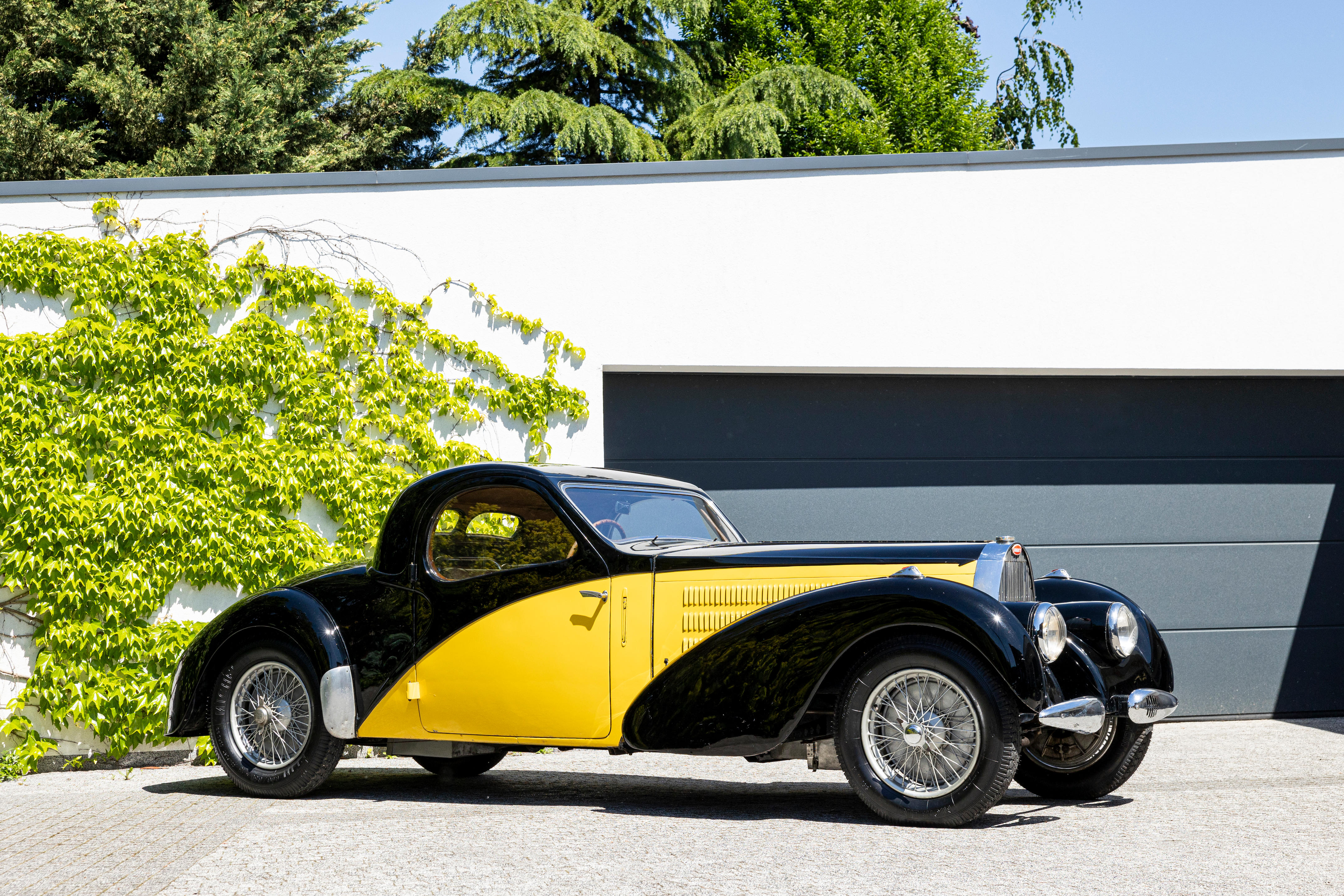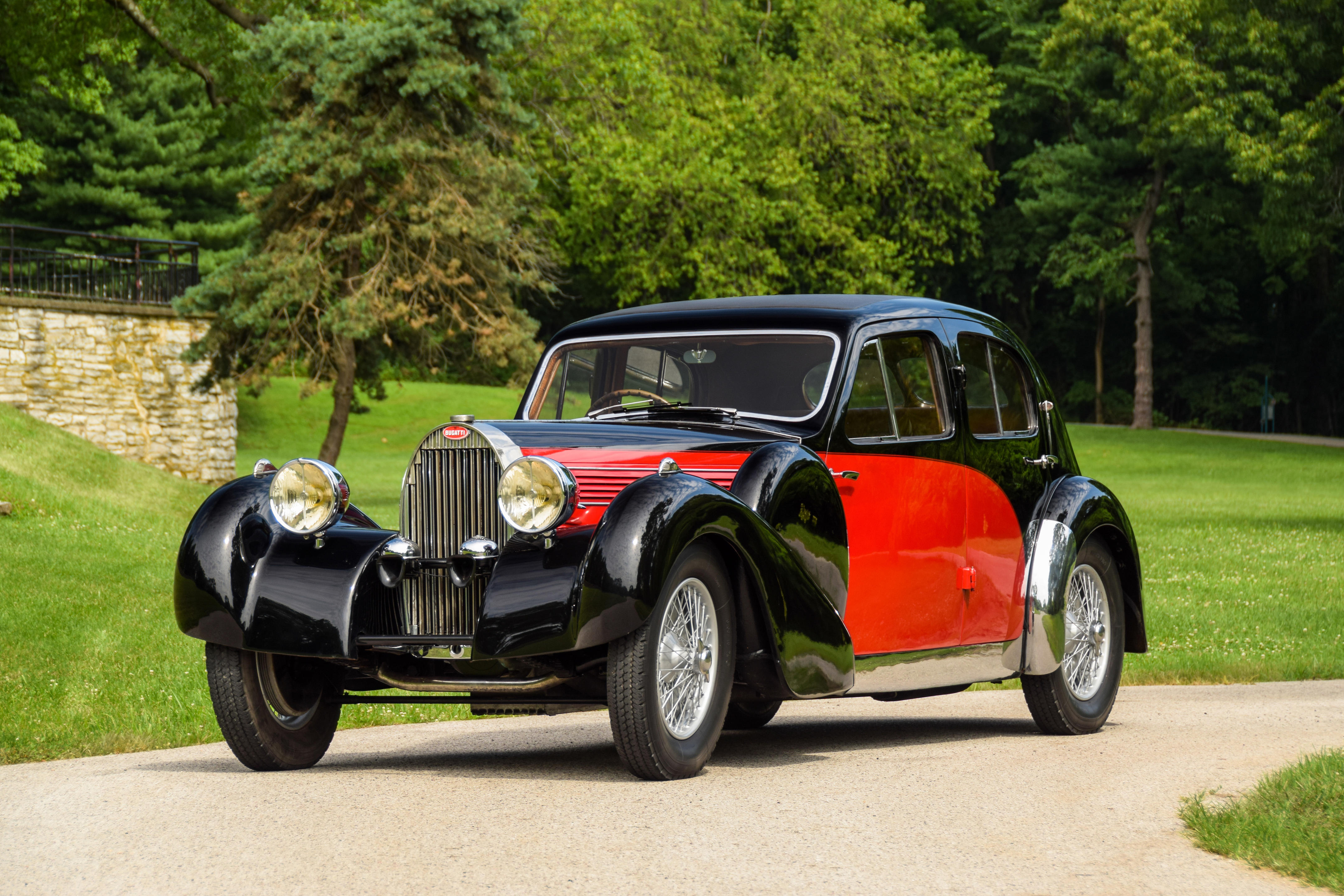'The car sped along at 80mph with the comfort and quietness one associates with the Type 57... We were quite willing to believe that Jean Bugatti has achieved the 435 kilometres to Paris in just under 1½ hours in the Type 57 - an average of 77mph...' - Motor Sport, May 1939. By the early 1930s Ettore Bugatti had established an unrivalled reputation for building cars with outstanding performance on road or track; the world's greatest racing drivers enjoying countless successes aboard the Molsheim factory's products and often choosing them for their everyday transport. Although Bugatti is best remembered for its racing models, most of the 6,000-or-so cars produced at the Molsheim factory were touring cars of sporting character. Produced from 1934 to 1940, the Type 57 exemplified Bugatti's policy of building fast and exciting touring cars possessing excellent handling and brakes. Because of its lengthy run of success, Ettore Bugatti had remained stubbornly committed to his single-cam engine, only adopting the more advanced double-overhead-camshaft method of valve actuation, after much prompting by his eldest son Jean on the Type 50 of 1930. From then on Jean Bugatti took greater responsibility for design, his first car being the exquisite Type 55 roadster, a model ranking among the finest sports cars of the 1930s. He followed that with a design of equal stature, the Type 57. A larger car than the Type 55, the Type 57 was powered by a 3.3-litre, double-overhead-camshaft straight eight of modern design, derived from that of the Type 51 Grand Prix car, and was housed in Bugatti's familiar vintage-style chassis. The range showed the strong influence of Jean Bugatti and at last gave the marque a civilised grande routière to match those of rivals Delage and Delahaye. The Type 57 was the firm's most popular model and attracted coachwork of the finest quality executed in a startling variety of styles but was no mere rich man's plaything, as evidenced by two outright wins at Le Mans. Proof, if it were needed, that ancestral virtues had not been abandoned when creating a car fit to rank alongside Rolls-Royce or Bentley. Its success is revealed by the production figures: some 630 examples of all Type 57 models were produced between 1934 and 1940, and the post-war Type 101 was based on its chassis. However, although many Type 57s were fitted with bespoke bodies, the most popular coachwork was built to Jean Bugatti's designs by the marque's preferred carrossier, Gangloff of Colmar, just a few miles from the Bugatti works at Molsheim. The car offered here is an example of the Roots-supercharged Type 57C competition model. Chassis number '57.577' was delivered on 8th October 1938 to Monestier, the Bugatti agent in Lyons, and first owned by industrialist Emile Glaizal. Its original body was made in standard Stelvio cabriolet style by Gangloff. After the war, in April 1947, Glaizal moved to Geneva, Switzerland, taking the Type 57 with him. The car was registered 'GE 12549', at which point it is noted that the car had hydraulic brakes all-round which it retains to this day. The registration changed to 'GE 11982' when Glaizal sold it to public works contractor and Bugatti collector, Gaston-François Riondel. Eventually the Type 57 ended up in the warehouse of the Geneva Bugatti agent, Jean Séchaud, and was purchased by Cäsar Schaffner, together with several others, after Séchaud sold up in the mid-1960s. Bizarrely, Séchaud had sold his cars for scrap! Schaffner decided to restore '57.577' in the style of '57.593', the Corsica-bodied Type 57S sports roadster first owned by Colonel G M Giles, a former chairman of the Bugatti Owners Club. Based in North London, Corsica was a relatively small firm that allowed clients considerable freedom in determining their cars' final appearance – surely the ultimate in 'bespoke' – an approach that endeared it to wealthy sporting motorists. The body of the Colonel's car was designed by his brother, Eric Giles. Regis
'The car sped along at 80mph with the comfort and quietness one associates with the Type 57... We were quite willing to believe that Jean Bugatti has achieved the 435 kilometres to Paris in just under 1½ hours in the Type 57 - an average of 77mph...' - Motor Sport, May 1939. By the early 1930s Ettore Bugatti had established an unrivalled reputation for building cars with outstanding performance on road or track; the world's greatest racing drivers enjoying countless successes aboard the Molsheim factory's products and often choosing them for their everyday transport. Although Bugatti is best remembered for its racing models, most of the 6,000-or-so cars produced at the Molsheim factory were touring cars of sporting character. Produced from 1934 to 1940, the Type 57 exemplified Bugatti's policy of building fast and exciting touring cars possessing excellent handling and brakes. Because of its lengthy run of success, Ettore Bugatti had remained stubbornly committed to his single-cam engine, only adopting the more advanced double-overhead-camshaft method of valve actuation, after much prompting by his eldest son Jean on the Type 50 of 1930. From then on Jean Bugatti took greater responsibility for design, his first car being the exquisite Type 55 roadster, a model ranking among the finest sports cars of the 1930s. He followed that with a design of equal stature, the Type 57. A larger car than the Type 55, the Type 57 was powered by a 3.3-litre, double-overhead-camshaft straight eight of modern design, derived from that of the Type 51 Grand Prix car, and was housed in Bugatti's familiar vintage-style chassis. The range showed the strong influence of Jean Bugatti and at last gave the marque a civilised grande routière to match those of rivals Delage and Delahaye. The Type 57 was the firm's most popular model and attracted coachwork of the finest quality executed in a startling variety of styles but was no mere rich man's plaything, as evidenced by two outright wins at Le Mans. Proof, if it were needed, that ancestral virtues had not been abandoned when creating a car fit to rank alongside Rolls-Royce or Bentley. Its success is revealed by the production figures: some 630 examples of all Type 57 models were produced between 1934 and 1940, and the post-war Type 101 was based on its chassis. However, although many Type 57s were fitted with bespoke bodies, the most popular coachwork was built to Jean Bugatti's designs by the marque's preferred carrossier, Gangloff of Colmar, just a few miles from the Bugatti works at Molsheim. The car offered here is an example of the Roots-supercharged Type 57C competition model. Chassis number '57.577' was delivered on 8th October 1938 to Monestier, the Bugatti agent in Lyons, and first owned by industrialist Emile Glaizal. Its original body was made in standard Stelvio cabriolet style by Gangloff. After the war, in April 1947, Glaizal moved to Geneva, Switzerland, taking the Type 57 with him. The car was registered 'GE 12549', at which point it is noted that the car had hydraulic brakes all-round which it retains to this day. The registration changed to 'GE 11982' when Glaizal sold it to public works contractor and Bugatti collector, Gaston-François Riondel. Eventually the Type 57 ended up in the warehouse of the Geneva Bugatti agent, Jean Séchaud, and was purchased by Cäsar Schaffner, together with several others, after Séchaud sold up in the mid-1960s. Bizarrely, Séchaud had sold his cars for scrap! Schaffner decided to restore '57.577' in the style of '57.593', the Corsica-bodied Type 57S sports roadster first owned by Colonel G M Giles, a former chairman of the Bugatti Owners Club. Based in North London, Corsica was a relatively small firm that allowed clients considerable freedom in determining their cars' final appearance – surely the ultimate in 'bespoke' – an approach that endeared it to wealthy sporting motorists. The body of the Colonel's car was designed by his brother, Eric Giles. Regis















Try LotSearch and its premium features for 7 days - without any costs!
Be notified automatically about new items in upcoming auctions.
Create an alert